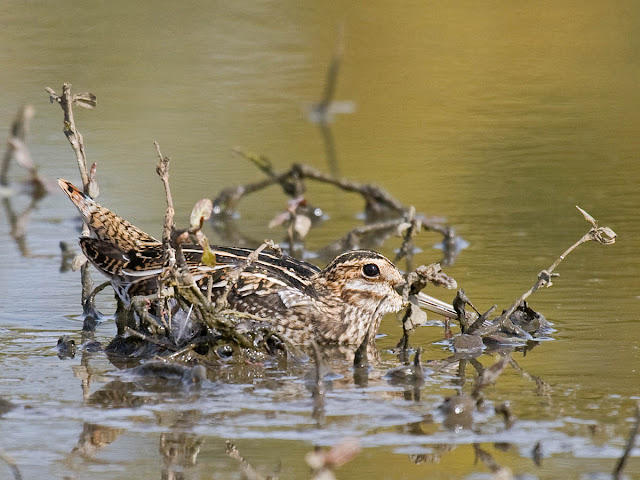If you are familiar with the local birds--so that identification skill is not the issue--then somehow these other birders found more birds in the same area. How? The answer might not be luck. It might be... fieldcraft. What is fieldcraft?
 |
| I see you. Do you see me? Wilson's Snipe. Oregon, October. Greg Gillson. |
Identification is about the bird: how it looks, sounds, behaves. Bird finding is more about the observer: how you look, listen, and behave.
These days there are many tools for identifying birds. There are field guides, online apps, and specialty books and articles dedicated to those hard-to-identify pairs or groups of birds. You know them: Accipiter hawks, Empidonax flycatchers, waterfowl in flight, hawks in flight, female hummingbirds, white swans, streaky sparrows, and more, depending upon where you live in the world.
There isn't a lot of information, though, on fieldcraft--finding birds that may be near you, but hidden from your view at the moment. Today people are more isolated from nature than ever. People don't understand the behavior of other wild living things, as perhaps did our ancestors. To remedy that need this article introduces the topic. It is my intention to create a series of articles on fieldcraft and post them here regularly. When, where, and how to find birds. How to approach birds without frightening them away. Equipment and tools. And more. (I've added a widget in the sidebar (web view) that leads to all posts labeled "fieldcraft." Check them out!)
If one article a month, or so, is too slow for you, there is one book I recommend every birder own in their personal library. It is the National Geographic Birding Essentials, published in 2007 and written by Jonathan Alderfer and Jon L. Dunn, both co-editors of recent versions of the National Geographic birding field guides. This 224 page book is nearly evenly split between identification and fieldcraft. It is a great overview of the topic.
Amazon Affiliate Link: (I receive a small portion of the sale if you buy from this link, with no additional cost to you!)

What a great series idea! Looking forward to these articles. I'd be interested to read your take on the ethics of pishing to attract birds.
ReplyDelete"Bird finding is more about the observer: how you look, listen, and behave."
"Today people are more isolated from nature than ever. People don't understand the behavior of other wild living things, as perhaps did our ancestors." - what nice lines.
Curious if you've read "What the Robin Knows" by Jon Young? It's not a book on birding, but it covers some of the topics you mentioned related to fieldcraft and how birds and other animals react to humans. You might enjoy it if you haven't read it.
Thanks for the comments, and the book recommendation. I'm all for pishing... it's talking to the birds.
ReplyDeleteBTW, tried to leave a comment on your blog, but it was rejected because it said it thought I was a bot!
Darn, sorry you had trouble, we'll fiddle with the settings. It does look like a comment came through eventually, though.
ReplyDeleteAre you still planning to feature articles on Fieldcraft for birding? I would be interested in any info and resources that you could provide. Barbara in Massachusetts
ReplyDeleteYes, Barbara. I have written a total of 7 "Fieldcraft"-named articles, plus labeled 7 other older articles as belonging to the Fieldcraft topic.
DeleteRead them all here:
https://sandiegogreg.blogspot.com/search/label/fieldcraft
Thanks for stopping by and leaving a comment!